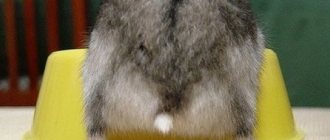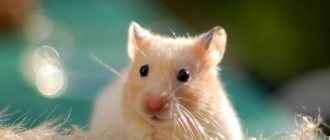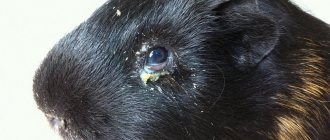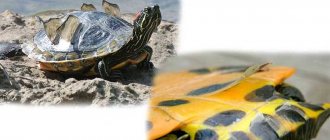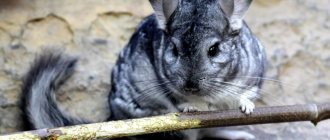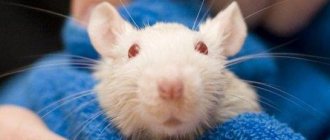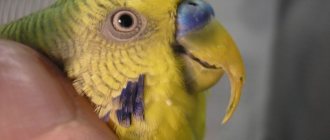In many countries, many families keep freshwater reptiles; the red-eared slider has become the most popular in recent years. This is a green turtle with red ears on its head. “The most aquarium reptile” is not aggressive, but sometimes it bites painfully. Anyone who expresses a desire to have a little aquaterrarium owner should think carefully. After all, this is not a cat or a dog, this is a reptile that will need water to swim, and land where it can warm up under a lamp.
You need to know why your charming pet might get sick. Diseases are most often the consequences of poor living conditions, improper care and nutrition, and contact with sick animals. The article talks about the most common disease - fungus, how to recognize it, and how to treat your pet if an infection occurs.
Causes and signs of diseases of red-eared turtles
Why do diseases occur in red-eared turtles? The reasons are due to the following factors:
- contacts with sick animals;
- varying in severity and nature of injury;
- stress after moving or as a result of changing climatic conditions;
- poor nutrition and lack of vitamins;
- violation of the temperature regime in the aquarium.
Since most of the time these animals behave calmly and move little, it is not always possible to recognize diseases of red-eared turtles at first glance. How can you tell if your pet is unhealthy? You should be wary if the following symptoms are found:
- The animal stays on the water surface for a long time.
- The turtle is lethargic and shows no interest in food.
- Bloody impurities appeared in the stool.
- A white coating is visible on the animal's skin.
- It is noticeable that the shell of the red-eared turtle is peeling off or the bones have softened.
- The animal has swollen eyes, from which green pus is released.
- The pet lies at the bottom for a long time, showing no interest in the world around it.
If you detect one or more of the listed signs, you should not postpone a visit to the veterinarian and try to treat the animal at home. If a turtle gets sick, it needs urgent specialist help and adequate treatment, otherwise some dangerous syndrome or intestinal disease will lead to the death of the individual.
Why do turtles get sick?
The causes of disease development are associated with provoking factors:
- decreased immunity due to relocation, acclimatization, or changes in living conditions;
- poor nutrition: lack of vitamins or obesity due to overeating;
- injury;
- change in water temperature;
- contacts with infected animals.
What do red-eared turtles suffer from?
There are a variety of diseases that affect red-eared turtles. Ailments are divided into main groups:
- Diseases of the bones and shell caused by a lack of vitamins in the animal’s body, especially calcium.
- Respiratory diseases. The most dangerous ailment is pneumonia in red-eared turtles.
- Intestinal diseases caused by pathogenic bacteria or occurring when helminths parasitize the body.
- Diseases of the hearing organs, in particular, otitis media in the red-eared turtle.
- Skin diseases of fungal and bacterial nature.
The listed ailments can lead to serious disorders in the turtle’s body if timely treatment is not carried out. In order not to start the disease, it is important to provide timely help to the animal, and for this you need to know the main symptoms and signs of each disease.
Causes of fungus
The appearance of the disease, the first sign of which is a white coating on the animal’s shell, occurs at any age. The causative agent of the disease is a fungus of the genus Candida; there are others, such as pathogenic fungi.
Red-eared turtles are not susceptible to the disease very often in natural conditions; this mainly occurs when kept in captivity. The causes of shell disease are different:
- Treatment of reptiles with antibacterial agents, which results in a decrease in the effectiveness of the immune system.
- High humidity.
- There is no place for heating with an ultraviolet lamp.
- Non-compliance with diet.
Article on the topic: Newborn rat pups: development, care and feeding of baby rats
It is still difficult for inexperienced turtle owners to correctly answer the question of why the shell of a red-eared turtle turns white and to predict the occurrence of a fungal infection. Although, at the first appearance of a white coating, you can guess that this is already an infectious breeding ground.
Typically, the fungus can manifest itself in a humid environment when the water temperature in the aquaterrarium reaches +26 degrees. At this temperature, the animal prefers to stay in the water longer and has no desire to dry out on the island. The favorable period for the proliferation of fungal infections is molting. At this time, the turtle’s skin loses its antiviral resistance.
It is recommended to maintain the water temperature from 28 to 26 degrees; on the island it should be at 28-32 degrees. Then the turtle will move to land to dry and warm up under a lamp or in the gentle sun. In such conditions, the fungus is unlikely to bother the pupil.
A place for heating should be arranged taking into account the size of the animal. The larger it is, the larger the heating area should be. Only in this way will the turtle be able to willingly go onto land and spend enough time there.
People who have had a turtle for more than one year probably know that if you treat your pet with antibiotics for a long time, this process almost always ends with the appearance of fungus on the shell. You need to start preparing for such an outcome in advance. The reasons for the appearance of fungus include the following:
- The water in the terrarium is hard.
- Stressful situations.
- Errors in nutrition.
- Presence of fungus.
You should never add water taken from the tap to the terrarium. Animals can get sick from such negligence.
Detachment of horny plates
This trouble is not a disease, but rather a consequence of various reasons. Some doctors consider this phenomenon as a symptom.
In normal condition, turtles' shells do not peel off and molting does not occur. But during the period of growth of the horny plates, this phenomenon occurs quite often. In adulthood, this can occur due to a lack of vitamins A and B2, improper content, the appearance of fungus or the influence of harmful algae.
If the shield comes off smoothly, then there is no need to worry.
In other situations, you should act accordingly:
- The shield is increased in size and extends only from the middle. This problem can be solved with increased feeding and vitamin replenishment. There is no harm in adding methylene blue to the water.
- The shield is divided into layers, inside it there are entire cavities. In the place where the shield was, a gray coating or brown crust remains. This is a consequence of the activity of the fungus. To get rid of it, you need to completely clean the aquarium, place the turtle separately and soak it in oak bark tincture. In addition to this, you need to add methylene blue to the main water. In any situation, treatment should last 2 weeks.
- The scutes come off only in a specific place, a softening of the healthy scutes is felt around, and an ulcer or blood remains at the place where they are located. This is a bacterial disease. In this situation, bluing will again come to the rescue, as well as clotrimazole ointment, and a complex of antifungal drugs. The turtle should be left in a dry place at night. It's better to consult a veterinarian.
Pathological shedding
Pathological peeling of the exoskeleton is called shell ulcer. It occurs mainly in mature individuals with weakened immunity due to vitamin deficiency, non-compliance with living conditions - cold, dirty water. The integrity of the keratin layer is disrupted and a fungal or bacterial infection penetrates the soft tissue. Suppuration develops, characterized by stench, ulceration and rejection of the stratum corneum.
Treatment consists of surgical removal of necrotic tissue, treatment of wounds with disinfectants, as well as antimycotic or antimicrobial agents. It occurs in stages so that an extensive wound surface is not created. If necessary, the herpetologist performs prosthetics with polymer materials until the stratum corneum is completely restored. The turtle owner will have to be patient - healing may take months. Therapeutic procedures will not be effective without providing the pet with comfortable housing, as well as adequate feeding.
Pneumonia
As it turns out, pneumonia can develop not only in humans, but also in turtles. This happens when the reptile’s body becomes hypothermic. The disease is considered serious, and if the pet does not receive timely treatment, there is a risk of death.
Signs of the disease can be noticed within 24 hours after the onset of the inflammatory process. The reptile will be on land or swimming on the surface more often, as it will lose the ability to dive. Pneumonia is treated with medication or using traditional recipes. It is possible to achieve the greatest efficiency only with an integrated approach:
- Intramuscular injections (drugs "Baytril", "Amikacin") are required - consultation with a veterinarian is required, as it is important to determine the exact dosage. If the dose is determined incorrectly, the medicine will not only not help, but can also lead to the death of the turtle.
- Methods of traditional medicine - steam inhalations and warm baths with a decoction of chamomile flowers have a high effect. The reptile is first held over steam and then immersed in liquid for 25-30 minutes. The optimal temperature of the solution for the treatment of pneumonia should not be higher than 30°C.
Various medications
Treatment tactics for heel fungus depend on the form of the disease. Usually a combination of tablets and external agents is selected. In the early stages, you can get by with only an ointment or solution. They help to effectively suppress microorganisms and lead to recovery. The course of treatment is two weeks. It must be completed to the end, even if the symptoms have disappeared.
Before applying the external product, the feet are steamed and washed with soap, and then wiped dry. The keratinized areas are carefully removed with a pumice stone or scraper. The medicine is applied to cleansed skin.
If necessary, the doctor prescribes tablets. Usually these are antibiotics. The most commonly used drugs are fluconazole, ketoconazole and others. The selection of medication must be done individually. They cannot be used during pregnancy and breastfeeding.
Hearing diseases
A common disease that affects the auditory organs of turtles is otitis media. Its main danger is that the disease can be asymptomatic for a long time, and as a result lead to serious health problems or death of the animal. You can suspect the presence of otitis media by the following signs:
- the animal has a swollen cheek and asymmetry of the head is observed;
- the turtle does not show interest in food and the surrounding reality;
- the coordination of the individual’s movements is impaired.
Otitis in turtles can be unilateral or bilateral, when the swelling is visible only on one side of the head or both cheeks have increased in size. With such a disease, three scenarios are possible:
- breakthrough of pus through the skin;
- exit of masses through the oral cavity;
- the need for surgical intervention.
In the first case, you will need to treat the wound formed after the breakthrough of pus with antimicrobial agents and healing ointments.
In the second case, when the pus does not break out on its own, you need to massage the problem area, lightly pressing on the swelling. After the purulent discharge begins to come out, it will be necessary to remove these masses from the animal’s mouth. When massages do not bring the expected result, surgery is performed, the purulent focus is opened, and the canals are washed. During the rehabilitation process after otitis, the animal will need vitamins and injections of calcium gluconate.
If your turtle sleeps too long or too little
In this case, you just need to observe the behavior of the animal. If the pet eats well, swims actively, communicates with other neighbors in the aquarium, i.e. behaves as usual, her health is safe. Typically, such periods of instability end after a few weeks, after which red-eared turtles spend the night in their usual rhythm.
If your reptile sleeps very little and is too active, it should be taken to the veterinarian. He will be able to clarify the reason for this behavior and prescribe sedatives and other medications. If turtles sleep a lot, literally for several days in a row, but wake up, feed, swim and fall asleep again, this is quite normal. If a sleeping turtle is not active at all, this may indicate the beginning of the development of the disease.
The only exceptions are those cases when the animal has gone into hibernation. This usually happens during the autumn-winter season, provided that the owner specially prepares the pet. To do this, reduce the temperature in the aquarium for several days in a row, significantly reduce portions or do not feed the turtle at all, etc.
Bone (shell) diseases
The main symptoms in this case are softening or peeling of the shell. This can occur both due to a lack of ultraviolet radiation (artificial or natural), and due to a lack of calcium in the body. In baby turtles, shell abnormalities indicate the presence of rickets. Detachment of the scutes is also possible when infected with a fungal infection.
In order to prevent softening of the shell, it is necessary to irradiate the terrarium with a special ultraviolet lamp at strict intervals. By the way, similar devices for terrariums from the German company Hagen have proven themselves to be quite good. It is also necessary to eat chopped fish with bones (it is advisable to grind the bones) to supply the body with calcium.
Fungal disease of areas of the shell is easy to identify. Under the peeling shield, brown crusts and a gray coating are visible.
This case is treated by daily washing the affected area with a solution of methylene blue for 30 days.
In more complex cases (ulcers and even blood stains are visible under the shield), it is recommended to use clotrimazole medicinal ointment. The ointment is applied to the affected area in the evening, and the patient is left on dry land overnight. During the day, you need to carry out the washing procedure in a blue solution.
If the vet is out of reach...
Having noticed that the turtle has begun to molt, the owner should examine it and observe carefully. If, in addition to detachment, no other deviations from the norm are identified, the animal behaves actively, there is no reason for concern.
Having discovered that the shell is peeling off very much and even crumbling, you should resort to special treatment, which is prescribed based on the diagnosis. (The symptoms of various “shell troubles” were discussed above).
Fungus. Pharmacies sell antifungal drugs Nizoral or Lamisil. They should be used to lubricate the damaged areas of the shell at night for two weeks, having first very carefully cleaned off the exfoliated tissue.
The fungus can cause irreversible degeneration in the tissues of the turtle “armor”
Such tissues must be carefully cleaned and BetaisodonaR ointment applied to the ulcerated area.
In the case of a fungal disease, “therapeutic baths” are recommended for the amphibian - bathing in chamomile decoction, a weak solution of potassium permanganate or malachite greens. The latter, by the way, is used to disinfect aquarium water.
The disease in its unadvanced stage can be treated quite successfully. If the fungus reaches the internal organs, it can cause the death of the animal.
The shell of a land turtle can peel off as a result of dehydration. In this case, daily bathing of the animal is recommended.
As for rickets, which, as we found out, is the result of a deficiency of vitamin D and calcium, here we are most likely talking not so much about the treatment of the disease, but about its prevention.
So, in the warm season, it is recommended to take the aquaterrarium with the turtle out into the fresh air, while protecting the reptile from direct rays of the daylight.
In the autumn-winter period, turn on the UV lamp. In the autumn-winter period, the dwelling with the amphibian must be placed under a UV lamp three times a week - literally for five minutes.
Before the procedure, it is recommended to cover the turtle’s eyes with a plaster so as not to harm the lens and retina.
To replenish the level of calcium in the reptile’s body, shrimp rich in this element will not be superfluous in its menu. Since this pleasure is not cheap, you can treat your pet with fish and bones instead. Bone meal, crushed egg shells, and chalk are very useful.
If the disease is advanced, the veterinarian, as already mentioned, will prescribe vitamin injections.
Skin diseases of the red-eared turtle
Despite the fact that skin diseases are not among the most common in the red-eared turtle, they are among the most dangerous for it. The reason for this is the alien natural environment. The slightest, even the most insignificant injury can cause a skin infection, which will immediately manifest itself in the form of ulcers, abscesses and deformed areas of the skin. In addition, skin lesions often go hand in hand with other, no less serious diseases and are only auxiliary or signs indicating the presence of something more serious. The most common skin diseases include the following:
- peeling of the skin.
- abscess.
- dermatomycosis.
Peeling of the skin is just one of the cases mentioned above, when the problem can be independent or a signal of something more serious. It is the formation of peeling scales on the body of a turtle and occurs when:
- mechanical injuries and damage.
- contracting an infection.
- hypervitaminosis (excess of various vitamins).
- lack of vitamin A and group B in the turtle body.
Only a specialist can name the exact reason after a thorough (and possibly comprehensive) examination. And only after diagnosis can a course of treatment be prescribed.
An abscess (purulent inflammation of tissue in a localized area) is a consequence of skin damage due to injury or the activity of parasites (for example, ticks). It “gives out” itself by forming a swelling at the site of injury (usually subcutaneously) and squeezing the tissues above it, which causes unpleasant and painful sensations to the turtle. It is dangerous because in the absence of treatment, tissue necrosis and death begins. Most often, abscesses are recorded in land turtles, but they are also found in red-eared turtles.
Abscesses are treated exclusively by surgical intervention:
- under anesthesia (0.5% novocaine), the swelling is opened and wait until all the pus comes out.
- the wound is washed with hydrogen peroxide, narrow gauze strips soaked in it are inserted into it and sprinkled with trypsin or chymopsin. Strips should be changed every day.
- in parallel, a course of antibiotic treatment is carried out as prescribed by the doctor.
Treatment is carried out until the abscess disappears.
Of the diseases mentioned, dermatomycosis is perhaps the most common, since its causative agent can rightfully be called a permanent resident of the aquarium. We are talking about a fungus of the genus Saprolegnia parasitica, which can cause such a dangerous and contagious disease as saprolegniosis in fish, and the already mentioned dermatomycosis in red-eared turtles. The source of the appearance of fungus in an aquarium is a high content of organic matter in the form of remains of uneaten food, and in natural conditions - dead shellfish, fish and other inhabitants of the reservoir. It consists of white thin branched threads-hyphae, with the help of which it penetrates into the tissues of the skin and begins its activity, the result of which, as in the case of an abscess, can be tissue necrosis and the possibility of damage to internal organs and muscles, ending in death. However, despite such a dangerous neighborhood, a turtle (like a fish) can become infected with this fungus only under certain conditions: cramped conditions (if it shares its home with someone else), polluted water with a temperature below +20, or an inappropriate level of acidity.
Externally, dermatomycosis manifests itself as:
- a grayish-white coating on the skin and shell of a turtle.
- deformation of the shell and detachment of the cornea plates.
- formation of granulomas.
- osteolysis (washing out of the mineral part) located under the horny plates of bones.
Like other skin diseases, it can often act as a concomitant illness and, further weakening the body, accelerate the death of your pet. Fortunately, this disease can be cured even at home. The only condition is your timely reaction to a suspicious raid, which tends to spread quickly.
In the early stages, dermatomycosis is treated by bathing the sick turtle for fifteen minutes in a solution of malachite green at a rate of 0.15 mg. per 1 liter of water or in a solution of potassium permanganate (potassium permanganate), prepared as follows: 1 gr. drug per 100 ml. water, then 1 ml. add the solution to 1 liter of water. After bathing, you need to lubricate the affected areas with Canesten cream containing clotrimazole, or Parkesterone or Panolog ointment. These procedures are carried out over 2-3 days with constant monitoring of the dynamics of the disease. With proper treatment, the fungus will disappear after the specified time. If dermatomycosis is in an advanced stage (that is, there are deeply affected areas), experts advise removing them and treating the resulting wounds with BetaisodonaR ointment, which contains povidone iodide. Some sources also recommend periodically treating the turtle with ultraviolet light, but you should consult a herpetologist about the advisability of this method and the dosage of radiation. But if dermatomycosis has reached the stage of bone destruction, treatment may take a long time, and it is not a fact that it will be successful.
Along with the main treatment, measures should be taken to improve the living conditions of the red ear - for example, finally changing the water in the aquarium or reviewing the diet.
In some cases, when diagnosing the activity of other bacteria or yeast, experts recommend treating ulcers with solutions of levovinisole, sea buckthorn oil, vinylin or concentrated vitamin A, as well as intramuscular injections of chloramphenicol (75 mg per 1 kg of weight). An indispensable condition for successful treatment is isolation of the reptile for approximately two weeks.
Causes
The following can cause the appearance of white spots on the shell:
- hibernation, which weakens the body;
- prolonged exposure to cold water;
- inability to go onto land and bask under an ultraviolet lamp;
- long-term treatment with antibiotics;
- increased water hardness;
- poor nutrition, in which the body is deficient in vitamins and calcium;
- bad light;
- frequent stress;
- salty water;
- mechanical damage to the shell.
The shell also turns white in some diseases:
- Dermatomycosis - the causative agents of the disease are microscopic fungi Candida and Aspergillus, which always live on the body of reptiles, but manifest themselves only in cases where the immune system is weakened. At the same time, grayish-white cotton wool-like spots and granulomas appear in the folds of the skin and on the shell. After some time, the shell begins to deform and delaminate. In advanced cases, necrosis is observed.
- Saprolegniosis is caused by Saprolegnia fungi. The turtle's skin begins to turn red, peel and flake off, white “pimples” form on it, and later ulcers, which eventually begin to bleed. The shell becomes covered with a white coating, reminiscent of a cobweb, and begins to crumble. In reptiles, muscle tone weakens, activity decreases, and claws wear off. In advanced cases, paralysis of the limbs and sepsis are possible.
- Ulcerative-dissecting disease of the shell - first, the fungus Candida albicans enters the animal’s body through wounds and cracks formed on the shell, and later the bacteria Aeromonas hydropholy. The disease is accompanied by the formation of ulcers covered with whitish films, the number of which is constantly growing.
- Necrosis - pathogenic bacteria and fungi cause tissue death. As a result, light areas become noticeable on the limbs, head and shell, which darken after a while. If left untreated, the limbs swell, the nails and edges of the jaws begin to deteriorate and fall out. The animal dies from exhaustion or blood poisoning.
- Another reason for a white shell is a violation of molting, due to which the shell is covered with exfoliated skin that resembles a whitish film. In this case, there is no need for treatment. It is enough to remove skin flaps in a timely manner, normalize nutrition and living conditions.
Article on the topic: Is a chinchilla lying on its side normal or a symptom of a disease?
Diseases caused by pathogenic fungi
Often, owners of red-eared and other aquatic turtles are faced with the fact that their pets are covered with spots and a coating that looks like a layer of cotton wool. A similar disease can be found not only in turtles, but also in other aquarium reptiles. Most often, the cause of this symptom is fungi, and to combat them the following actions must be taken:
- treatment of damaged areas with a 1% solution of potassium permanganate, a similar procedure is carried out within 3-5 days;
- additionally, antifungal ointment is applied to the tissue - “Exifin”, “Atifin” and other analogues;
- All items in the aquarium must be disinfected - they will have to be boiled.
How to treat fungus in turtles
Increased nutrition will help the turtle get back on its feet faster
Treatment, of course, should be handled by a veterinarian. However, small towns do not always have specialists who can treat turtles, or owners may not be able to show their pet to specialists. In this case, in order to prevent the pet from dying and the fungus from growing, it is worth taking the initiative into your own hands.
- First of all, be sure to isolate the sick turtle from others. If you let her walk around the house, limit her movements. At the moment, she is a carrier of a fungal infection and is subject to strict quarantine. About walks for turtles.
- In the terrarium for her, increase the temperature to 30 degrees.
- It is better to avoid soil; instead, it is better to use paper towels or disposable diapers. This will make it easier for you to keep the terrarium clean and carry out periodic disinfection.
- Every day, for the first 7-10 days, treat the turtle's shell with a 3% solution of hydrogen peroxide, and carefully remove easily separated pieces of skin and shell with tweezers. There is no need to specifically tear them off; they should fall off on their own.
- Treating fungus in a turtle is a fairly lengthy process that can take up to 1-2 months, so you will have to be patient and take medications.
- Give the sick turtle daily baths in diluted betadine or monclavite (ratio 1 to 1), immersing it in such a bath for 30-40 minutes. You need to bathe her in this way for a month, trying not to miss a day.
- After bathing, when the shell is dry, the inflamed areas of the skin and shell can be lubricated with antifungal ointments based on Terbinafine. The course of lubrication is 3-4 weeks.
- It is also necessary to make compresses with chlorhexidine. To do this, take a gauze napkin, soak it in the solution, cover it with polyethylene, and secure it to the lower shell with a medical plaster. The longer the turtle wears the compress, the better. However, don't forget that the plastron also needs to breathe and dry, so give it breaks from the compress.
- If droplets of blood are observed on the scutes of the shell, or if the pet’s mouth or nose is bloody, give the sick turtle vitamin C daily. It is recommended, if no improvement is observed, to inject Dicinon at the rate of 0.5 milliliters per 1 kilogram of the turtle’s weight, 1 time every other day , within 5-7 days. This therapy will restore and strengthen the walls of blood vessels and prevent bleeding.
- In some cases, when it comes to treating relapses, an advanced form of a fungal infection, the use of antibiotics is appropriate.
Bone diseases
Signs of rickets, detachment and softening of the shell appear for the same reasons: due to insufficient absorption of calcium and other elements necessary for this process, as well as due to a deficiency of ultraviolet radiation. The main symptom of the pathology is thickening of the bones, while their structure and shape are disrupted.
It is difficult, but possible, to detect softening of bone tissue at the initial stage. If you carefully observe your pet, you will notice that the turtle has become lethargic and moves less than usual. This is exactly how reptiles with bone problems behave. If the shell has already softened, this is noticeable immediately: initially, the keratinized particles begin to peel off, and then the hard structure of the shield is replaced by a soft one, and perhaps even a change in shape.
You should consult your veterinarian before treating your turtle for bone disease. He will determine the causes of the disease and prescribe appropriate therapy. Most often it consists of taking vitamin and mineral preparations: Eleovita, Intravita, Multivita. If required, treatment is supplemented with other measures.
If you have bone diseases, your pet's diet needs to be adjusted. Redfish are given small fish with bones. In addition, for preventive purposes, it is recommended to place the reptile under a UV lamp, starting with 5-minute procedures, gradually increasing the time.
Symptomatic treatment
Methylene blue will help eliminate white plaque (namely, get rid of plaque, but not the very reason that contributes to its appearance) - you can buy it at the pharmacy. Warm water (about 30⁰C) is poured into the aquarium and the drug is added to it until a light blue color appears. The turtle is allowed into the water for the whole day. In this case, it is imperative to prepare an area with a lamp under which the animal can warm up. At night the turtle is taken out of the water. Repeat for several days.
If desired, methylene blue can be replaced with malachite green, potassium permanganate or trypaflavin. You can also place the turtle in a bath of oak bark infusion for an hour.
Another way to quickly get rid of white spots is to wipe the shell with lemon juice.
But the above methods of therapy only relieve symptoms. To determine the causes of the pathology and cure the disease, you need to contact a veterinarian.
Redness and swelling of the eyes
As a rule, such diseases occur due to poor turtle hygiene. Eye diseases are called ophthalmological. Symptoms are: the eyes may become swollen and cannot open, the eyelid is swollen and may stick together, the turtle cannot open the eyes, redness of the mucous membrane, a film on the eye, clouding of the cornea, loss of vision, fear of bright light, intense lacrimation, discharge from the eyes, decreased activity of the animal . The likelihood of ophthalmology occurs when the body is weakened after another illness.
When a disease is detected, it is important not to self-medicate, but to consult a doctor who will select the appropriate course. There are many eye diseases in water turtles, and they are easy to confuse - only a specialist will be able to determine exactly what needs to be done to ensure good health.
Diarrhea
Diarrhea is most often caused by poor or stale food. In addition, diarrhea may occur due to intestinal injury.
How do I recognize diarrhea?
Feces are mushy, runny, or have a strong odor.
It is necessary to limit food intake for a week. In this case, daily bathing is recommended, in addition, you need to make sure that the animal drinks a lot of water. It is necessary to control the turtle's weight; for this, it is recommended to weigh it regularly. If you do not see any improvement, contact your veterinarian immediately! In the absence of damage to internal organs, the prognosis is positive.
Lack of calcium and vitamin D3
A substance such as calcium is very important for turtles, because the formation of the shell, skeleton, and beak depends on its presence. With a severe deficiency of such a substance, this animal simply cannot live. She is lethargic and moves little.
Calcium deficiency is not always preceded by a low amount of calcium in the feed. There may be enough of it, but it will not be absorbed.
Vitamin D3 helps absorb this substance. It should also be present in the diet. However, it is important to know when to stop: an excess of vitamin D is worse than a deficiency.
Ultraviolet radiation also affects calcium absorption. It must be provided in accordance with the rules for keeping the animal.
Symptoms of calcium deficiency are: the shell loses its shine, flaws, cracks, and sometimes holes appear. At the first appearance of such problems, it is necessary to treat by adding calcium stone and more vitamin D to the food, as well as increasing ultraviolet radiation on the turtle.
Features of care during molting
During the molting period, the reptile needs special care. She needs to continue to be fed as before, but the pet’s diet will need to be changed. The animal requires more calcium and vitamins.
During molting, it is worth giving your pet shrimp and lean fish, for example, hake. To replenish the reptile’s body with calcium, they must be fed along with the bones. There is no need to be afraid that your pet will choke; its jaws are designed for chewing such food.
After consultation with a herpetologist, you can give special multivitamins designed specifically for young animals. During the molting period, it is important to monitor the cleanliness of the water in the aquaterrarium where the reptile lives. After all, at this time you can notice pieces of skin and shell on the surface of the water, which can begin to rot and cause the pet to become ill. To prevent this, you need to change the water in the terrarium as often as possible
Sometimes owners try to help the reptile get rid of flaking skin and shell. But this is allowed only in extreme cases, if the dead tissue does not fall off for a long time and causes discomfort to the animal. You can wipe the turtle with a decoction of chamomile flowers or use a soft toothbrush to clean the animal’s shell. This must be done carefully so as not to injure the reptile.
If the owners do not pay attention to the exfoliated areas of skin for a long time, the pet may get sick or scratch itself, trying to get rid of the dead epithelium. You can take the reptile out of the aquaterrarium for a while and wait until the animal is completely dry. Dry tissue will peel off more easily and fall off when your pet swims in the water.
During molting, experts recommend bathing the animal. This is necessary to remove remaining dirt from under the shell scutes and to prevent them from rotting. To bathe your pet, you need a shallow dish with low sides. Pour warm water into it and add baking soda. You need 7 g per liter of water
Carefully lower your pet into the liquid. In this case, you need to ensure that the reptile’s head remains on the surface.
The duration of the bath is 20 minutes. After its completion, excess water is blotted with a towel, and the shell is greased with olive oil. Just a few drops are enough.
Intestinal diseases
The animal can become infected with parasitic worms (helminths).
They enter the body through contaminated foods (fish or meat), as well as after drinking contaminated water. If this happens, you can cure the turtle using a folk remedy: for 5 days, feed it only raw carrots, grated on a medium grater. A dangerous disease is salmonellosis, caused by intestinal bacteria. The animal develops loose stools with a very unpleasant odor, general apathy, and weight loss.
This disease can only be treated in a veterinary clinic, and the sooner the turtle’s owner goes there, the better. Otherwise, the death of your pet is inevitable.
How can you tell if a turtle is infected with a fungus?
It is extremely difficult for a non-professional to make an accurate diagnosis based on external manifestations alone. Although an experienced doctor can draw conclusions about the animal’s condition during an examination. But to identify a fungal infection, additional research is necessary. And after receiving the diagnostic results, the specialist will be able to tell whether your pet is suffering from an infectious disease.
It is extremely important to find the true reasons for the appearance of white plaque, and not act at random. Without an accurate diagnosis, you should not experiment with any drugs, especially antifungal agents, which can be very toxic and even life-threatening for the turtle. The use of certain products may cause the shell to peel off.
Necrotizing stomatitis
Stomatitis is a lesion of the oral mucosa.
When the skin dies, stomatitis becomes necrotic. Externally, the disease manifests itself as follows: the turtle’s tongue becomes inflamed, mucus begins to flow from the mouth, later the gums become hyperemic, and the disease is difficult to bear. Doesn't eat anything. Stops eating food. It is rare that stomatitis comes alone; it usually causes many other diseases.
For treatment, the temperature should be increased by 6 degrees, bacterial preparations should be administered, and decamethoxin should be added inside. Purulent discharge must be removed from the mouth with a swab and tweezers.
Photo and video
Photo 1. White spots on a turtle's shell
Photo 2. White coating on a turtle’s shell
Photo 3. White shell of a turtle
Video 1. White shell of a turtle
Disease Prevention
This is a very important factor in the health of a domestic amphibian, and preventive measures are closely related to compliance with maintenance rules.
To prevent rickets and softening of the shell, the concentration of calcium in the body should be maintained. Especially for young cubs, bone meal should be added to their food daily. It will also be useful for adults (1 teaspoon once a week).
The risk of intestinal diseases is sharply reduced if you feed your pet only high-quality products. Greens and vegetables must undergo mandatory heat treatment. Don’t neglect special vitamin complexes for turtles.
The aquaterrarium should be kept clean, the water should be changed regularly, waste should be removed, and the required dose of UV radiation, temperature conditions, and normal ventilation should be provided.
Unfortunately, there are not so many veterinarians specializing in the treatment of amphibians. In some localities there are simply no veterinary clinics or offices. However, a recommendation from a veterinarian or an experienced turtle owner can always be obtained via the Internet. The main thing is to do this as quickly as possible and immediately begin proper treatment of your sick pet.
Pathological causes similar to molting and therapeutic measures to eliminate them
After growing up, red-eared turtles and land turtles do not molt, so the reason always lies in pathology
If the reptile is still young, then pay attention to the accompanying symptoms. The disease usually causes:
- decreased activity;
- loss of appetite;
- itching;
- infectious lesions (runny nose, conjunctivitis);
- disruption of the gastrointestinal tract.
With such signs, the animal should be shown to a doctor, since ignoring the problem can result in death.
Trauma to a turtle's shell
The cause of peeling may lie in poor maintenance. If cleaning is poor, the water in the pool becomes dirty and becomes covered with algae, which spread to the shells. Attacked by overgrown plants, the shell peels off and falls off. To help the turtle, apply Lugol's solution with glycerin or a 1% solution of copper sulfate to its shell.
Among the main diseases reminiscent of the molting process are:
- rickets;
- mycosis;
- avitaminosis or hypovitaminosis.
Let's take a closer look at them.
Rickets
When rickets develops in a sick animal:
- the shell is bent and individual scutes are peeling off;
- the eyeballs swell, which leads to complete closure of the eyes;
- Appetite is impaired due to crooked jaws, which make it difficult to absorb food.
Manifestation of rickets in a turtle
Due to the symptoms that appear, the turtle may die due to exhaustion. At the first signs of illness, your pet should be taken to a veterinary clinic to make a diagnosis and receive recommendations for treatment.
Deformation of the shell and failure of the hind limbs with rickets
Mycosis
Fungal diseases affect reptiles with weakened immune systems due to:
- recent hibernation;
- low temperature in the terrarium;
- poor quality diet;
- past infections;
- dirty water.
For mycosis in a turtle:
- the skin peels off and sheds;
- white spots appear on the shell, which can be easily cleaned off with a cotton swab;
- severe scabies occurs;
- Pimples and swellings form on the skin, developing into ulcers due to scratching.
Manifestation of mycosis in a turtle by the appearance of white spots
A sick animal needs to change its living conditions by increasing the frequency of cleaning the terrarium. To select medications, consult your veterinarian. The list of main drugs is presented:
- Lamisil;
- Baytril;
- Nizoral;
- Betadine.
To improve the condition, irradiation with a UV lamp and taking multivitamins are also recommended.
Avita- or hypovitaminosis
The essential vitamins needed for good reptile health include:
- calcium, responsible for bone tissue;
- vitamin D3, which regulates the functioning of the immune system and endocrine glands;
- vitamin A, which slows down the aging process and stimulates the growth of new cells.
Disorders in the musculoskeletal system due to lack of vitamins
With a poor diet and lack of vitamins in a turtle:
- the skin begins to peel off;
- armored shields peel off;
- rhinitis and blepharitis appear;
- loss of appetite;
- deformation of the paws is noted;
- the intestine falls out of the anus;
- the mucous membranes of the eyes turn red;
- bite changes;
- stool is disturbed;
- It is difficult to rise on the limbs due to increased fragility of the bones.
Pathological peeling of the skin more than twice a month
To restore health, consult a veterinarian and create an individual diet that takes into account the characteristics of your pet.
What other health problems might owners of red-eared turtles face?
In fact, for all their vitality, reptiles are still prone to many diseases. The following changes in condition should alert the owner:
- The appearance of mucous discharge from the nasal or oral cavity . This symptom signals a viral disease or vitamin A deficiency. In these conditions, the cornea and the epithelial layer located in the reptile’s nose are affected.
- Swelling in the ear area . In red-eared turtles, these areas are marked with red stripes. Most often, swelling occurs due to otitis media. It can be practically invisible, not exceeding a few millimeters in volume, or significant, such tumors are measured in centimeters. Otitis often develops due to hypothermia, much less often due to injury to the turtle.
- Roll while swimming . This can happen for two reasons: the turtle swallowed stones or contracted pneumonia. In the first case, it is worth observing the behavior - if the reptile passes a lot of stones, then everything is in order, and it does not have intestinal blockage or other problems with the gastrointestinal tract due to what it has eaten. Most likely, the owner will have to remove small particles from the tank, leaving only those stones whose size does not allow the inhabitant to “profit” from them. Often such an eating disorder is associated with a lack of minerals in the body; it is worth consulting a veterinarian on this issue. When your pet has pneumonia, other signs of illness also appear: swelling of the eyelids and discharge from the sinuses.
- Swelling of the limbs . This is one of the main symptoms of gout, a joint disease caused by the accumulation of uric acid. The disease develops against the background of serious disturbances in the functioning of the kidneys, dehydration, or abnormally intensive growth of young animals. More often, the disease is detected by chance, less often - changes are detected on x-rays. Sometimes turtles show similar signs not because of gout, but because of arthritis, and then the reptile’s limbs fail. Other signs of gout include bloating of the body, swelling of the eyelids, enlargement of large joints and slight swelling of the area under the jaw. The disease is serious and requires treatment. Moreover, positive results can be achieved only in the initial stages of the pathology. And when changes become obvious, therapy is ineffective.
- Lethargy, apathy . If the behavior of the turtle has changed, it behaves less actively and more often prefers to lie down, it is worth taking a closer look at the condition of the reptile. First of all, you need to observe your pet; perhaps you will be able to identify other signs of the disease. With many diseases, lethargy and weakness are symptoms, so if the pet’s condition worries the owner, it is worth visiting a veterinary clinic with him. If you ignore such signs, you may lose your four-legged friend.
Many diseases are contagious, so a sick aquarium inhabitant should be immediately separated from the rest of the inhabitants. Newcomers should first be kept in quarantine. In many ways, the health of red-eared sliders is related to the conditions of their detention and the quality of food. And these factors depend on the owner - the more he pays attention to his pets and cares about their comfort, the longer they will delight with their presence.
AQUARIUM FOR THE RED-EARED TURTLE: CONTENTS, CARE, PHOTO, DESCRIPTION.
RED-EARED TURTLE: CONTENT, BREEDING, DESCRIPTION, FEEDING, PHOTO, VIDEO, CARE.
TURTLE: CARE, REPRODUCTION, FEEDING, DESCRIPTION, PHOTO, VIDEO
Eye infections
Diseases of the visual organs in red ear are most often diagnosed:
- Conjunctivitis can be caused by dirty water in the aquaterrarium, staphylococci and streptococci. It can also be observed against the background of rickets, pneumonia, and vitamin deficiency. The fact that a reptile has conjunctivitis is indicated by a number of symptoms: the eyes are red, pus is released from them, and the eyelids are swollen. The pet’s general well-being also suffers: it becomes lethargic, does not eat anything, and is indifferent to what is happening. The reptile constantly rubs its sore eyes with its front paws; in advanced cases, the eyes close completely. In case of illness, antibiotics are indicated.
- Panophthalmitis occurs when germs penetrate under the cornea of the eye. This disease causes clouding of the eye and damage to the lower eyelid. Antibiotic therapy is prescribed, and sometimes removal of the eye is required. What to do if this pathology develops should only be decided by a doctor.
Diseases in which the skin peels off
It is normal for a reptile's skin to peel and flake off during the molting period. As soon as the animal is raised, everything is over.
But sometimes peeling skin can be a sign of pathology.
The clinical picture of the following diseases resembles the molting process:
- Mycosis. Most often, a fungal infection develops in the spring, when the animal’s immunity is weakened, especially if it hibernated. With this disease, you can notice a white coating on the skin, which can be easily removed with a cotton swab. If the animal moves and touches various objects, then white stripes remain on them.
- Rickets. With this pathology, the shell becomes bent and may begin to peel off. The eyes may become swollen, causing them to close completely. Due to the curvature of the jaws, the turtle does not eat anything, which can cause death.
- Hypovitaminosis. If an animal’s diet is monotonous and it does not receive all the necessary vitamins, then it may develop vitamin deficiency. Hypovitaminosis A is manifested by peeling of the skin. There is desquamation of large scutes on the limbs and head, marginal blepharitis, in which the eyelids swell, and the cloaca prolapses. The reptile grows a “parrot-like” beak. Often, with hypovitaminosis A, a runny nose is observed, so the disease is confused with a bacterial infection. Also, the animal may not eat anything, which will cause the reptile to become exhausted. To prevent the development of vitamin A deficiency, the pet must constantly receive liver, fish entrails, carrots, and pumpkin.
To exclude these pathologies, it is advisable to show your pet to a herpetologist, who, if necessary, will select adequate therapy.
If this is not possible, then you should carefully examine the reptile. When the animal is active and does not exhibit any alarming symptoms, then most likely the peeling and detachment of the skin is associated with molting and there is no cause for concern. This means that the red-eared slider is developing correctly.
WHAT TO DO?
The reason why the red-eared turtle has lost its appetite can be eliminated either independently or with the help of a veterinarian. It all depends on how serious the situation is.
If you feed frequently, you should reduce the amount and start giving as much food as the turtle can eat at one time. Leftover food is immediately removed
, otherwise they may spoil, which will lead to illness if the turtle decides to finish them. Most often you can give vegetables and herbs. Adult turtles are mainly herbivores, so they are fed protein foods periodically.
When preparing a turtle for hibernation, you need to bring it out of this state. Reptiles of this species hibernate under certain conditions that are almost impossible to create at home. A turtle may fall asleep and never wake up, especially if for some reason it is weakened and exhausted.
In the aquaterrarium, you need to increase the water temperature to 28 degrees, make the lighting brighter
and long lasting. Daylight hours should be increased by two or three hours.
It should be noted that for female turtles of this species, sexual maturity occurs at the age of four years. Males are ready to reproduce at the age of five. Therefore, if the reptiles are younger, the reason for refusing to eat lies elsewhere.
Video: getting to know your pet
For a sick turtle, it is advisable to determine the symptoms
. When there are no visible causes and the development of the disease has not been identified, it is advisable to consult a veterinarian. During the examination, possible causes of the disease will be identified, the correct treatment will be prescribed and the necessary manipulations will be carried out. In addition, the veterinary clinic will give the necessary recommendations for further care of the turtle. Very often, experts recommend taking special vitamin complexes for freshwater reptiles.
Predatory pets
The little red-eared turtle loves to eat raw meat because it belongs to the category of predators.
It is worth remembering that the cute, now domestic, red-eared turtles were once part of the wild, in which they had to fight for survival. They defended themselves from lovers of turtle meat (both on land and in water), and competed for the best place in their flock. Therefore, careless play with this animal (especially at the time of eating, mating or pregnancy) can turn into a big nuisance.
The fact is that this predator can perceive such games as an attack on its peaceful existence and react very hostilely. This animal demonstrates its displeasure by strongly biting its ill-wisher.
Although these reptiles do not have teeth, the bite force of a turtle can be quite impressive. The animal’s powerful jaws bite into the “enemy” with an “iron grip” and often leave a bloody wound that takes a long and painful time to heal.
The red-eared slider is named for the colored stripes behind its eyes, but these animals do not have ears.
